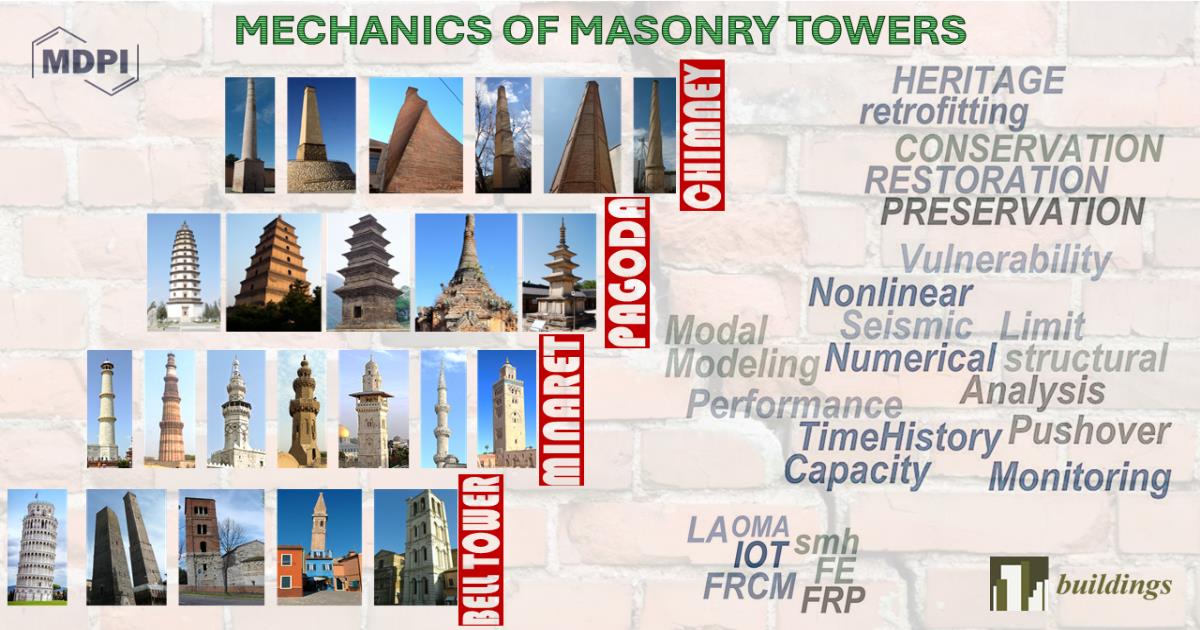- 3.1Impact Factor
- 4.4CiteScore
- 15 daysTime to First Decision
Mechanics of Masonry Towers
This special issue belongs to the section “Building Structures“.
Special Issue Information
Dear Colleagues,
Masonry towers, with their historical and cultural significance, stand as enduring testaments to human ingenuity and architectural excellence. These structures, ranging from medieval church spires and bell towers to defensive watchtowers and iconic minarets, have not only defined skylines, but also embodied the socio-cultural narratives of their times. The unique structural characteristics and aesthetic appeal of masonry towers present a rich area of study and pose distinct challenges in terms of analysis, preservation and adaptation to modern needs.
This Special Issue aims to collate cutting-edge research and insights from a multidisciplinary perspective, focusing on the engineering, architectural and conservation aspects of masonry towers. Contributions will explore both the historical context and the latest technological advancements in the analysis and preservation of these iconic structures.
Key Topics:
Structural Analysis and Modeling: The Special Issue will delve into advanced methods for assessing the structural integrity and behavior of masonry towers. This includes finite element modeling, non-linear analysis and the study of seismic vulnerability.
Seismic Performance and Retrofitting: Given the vulnerability of masonry towers to seismic activities, this Special Issue will highlight innovative retrofitting techniques and materials. Studies which cover strategies to enhance seismic resilience, while respecting the architectural and historical value of these structures, are welcome.
Material Characterization and Conservation Techniques: Contributions will focus on the characterization of historic masonry materials, including stone, brick and mortar. The Special Issue will explore both traditional and modern conservation techniques aimed at prolonging the lifespan of masonry towers. This includes the use of compatible materials for restoration, innovative reinforcement methods and the role of digital technologies in conservation efforts.
Heritage and Cultural Significance: The Special Issue will also address the cultural and heritage aspects, discussing the importance of masonry towers in urban and rural landscapes.
Case Studies and Practical Applications: Real-world case studies highlighting successful projects, as well as lessons from failures, will provide valuable insights. These case studies should cover a range of issues, from structural interventions to complete restorations, offering a comprehensive view of current practices and methodologies.
Similar modern structures inspired by masonry towers: Other case studies, built with different materials, but fundamentally representing key feature similarities with towers are welcome, providing insight into their construction techniques, importance and other peculiarities.
This Special Issue on masonry towers aims to serve as a comprehensive resource for academics, professionals and practitioners involved in the study and conservation of these iconic structures. By fostering a deeper understanding of both the historical and technical dimensions of masonry towers, we hope to inspire innovative approaches that will ensure the preservation and continued relevance of these architectural treasures for future generations.
We invite researchers, engineers and architects to contribute their knowledge and experience, fostering a collaborative dialogue that bridges the gap between tradition and innovation in the preservation of masonry towers.
Dr. Rafael Shehu
Dr. Ahmad Basshofi Habieb
Dr. Maria Gracia López Patiño
Guest Editors
Manuscript Submission Information
Manuscripts should be submitted online at www.mdpi.com by registering and logging in to this website. Once you are registered, click here to go to the submission form. Manuscripts can be submitted until the deadline. All submissions that pass pre-check are peer-reviewed. Accepted papers will be published continuously in the journal (as soon as accepted) and will be listed together on the special issue website. Research articles, review articles as well as short communications are invited. For planned papers, a title and short abstract (about 250 words) can be sent to the Editorial Office for assessment.
Submitted manuscripts should not have been published previously, nor be under consideration for publication elsewhere (except conference proceedings papers). All manuscripts are thoroughly refereed through a single-blind peer-review process. A guide for authors and other relevant information for submission of manuscripts is available on the Instructions for Authors page. Buildings is an international peer-reviewed open access semimonthly journal published by MDPI.
Please visit the Instructions for Authors page before submitting a manuscript. The Article Processing Charge (APC) for publication in this open access journal is 2600 CHF (Swiss Francs). Submitted papers should be well formatted and use good English. Authors may use MDPI's English editing service prior to publication or during author revisions.
Keywords
- static analysis
- dynamic analysis
- seismic risk
- retrofitting
- structural monitoring

Benefits of Publishing in a Special Issue
- Ease of navigation: Grouping papers by topic helps scholars navigate broad scope journals more efficiently.
- Greater discoverability: Special Issues support the reach and impact of scientific research. Articles in Special Issues are more discoverable and cited more frequently.
- Expansion of research network: Special Issues facilitate connections among authors, fostering scientific collaborations.
- External promotion: Articles in Special Issues are often promoted through the journal's social media, increasing their visibility.
- e-Book format: Special Issues with more than 10 articles can be published as dedicated e-books, ensuring wide and rapid dissemination.

